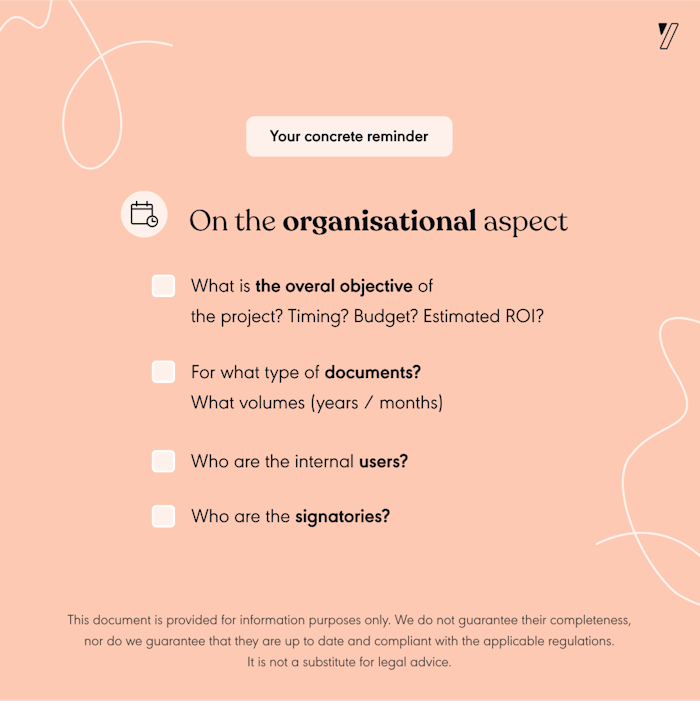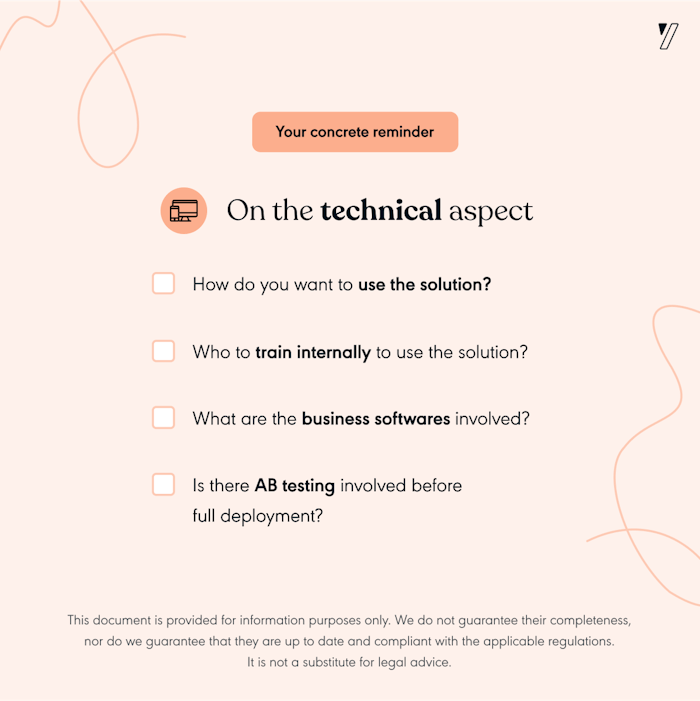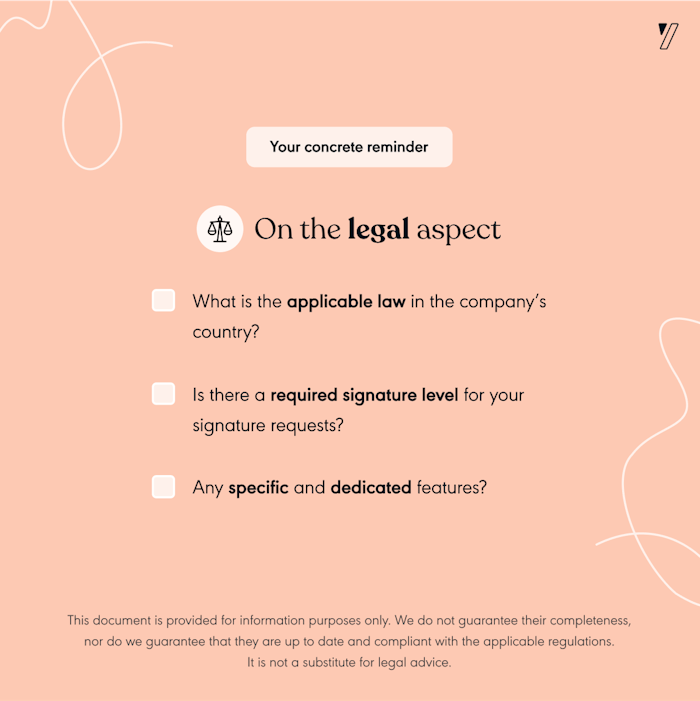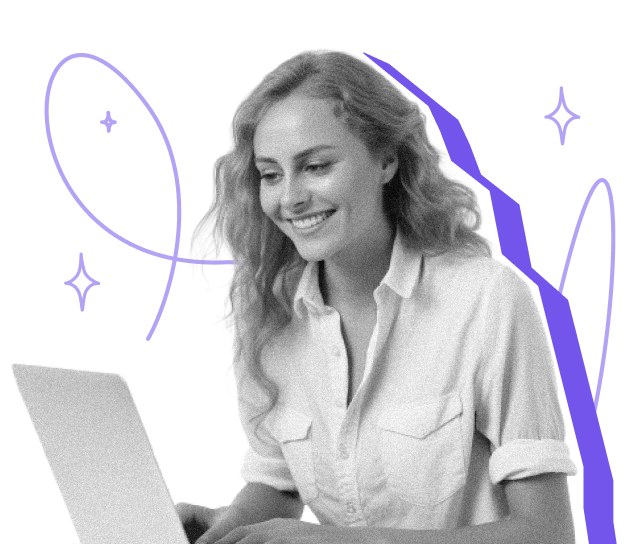As with any major project, embarking on the journey of deploying eSignature in a company requires preparation! 🏋♀
You’ll have to start by identifying what specific need is to be met by eSignature, such as efficient management of commercial contracts or streamlining document archiving by making an entire part of your activity paperless.
This article will give you all the information you need to hone your thinking about the organisational, technical, and legal aspects of eSignature before deploying itt.
Contents
Key principles of eSignature
That’s right. We’ll start by telling you more about eSignature itself!
To take better charge of your initiative, you’ll need to keep some basics in mind.
In practical terms, eSignature is a computerised system using an intangible, invisible cryptographic process to link an electronic certificate with the signed data and incorporate it into the unalterable PDF format.
1- Legal value
Legally speaking, eSignature is governed in Europe by the eIDAS Regulation, which defines the rules for its use.
You should also know that in France, the ANSSI (French National Agency for the Security of Information Systems) is responsible for the implementation of eIDAS.
The eSignature procedure must therefore meet a number of criteria:
- identification of the signatory,
- evidence of the signatory’s consent,
- guaranteed integrity of the signed document (to prevent any document modifications after the fact).
2- eSignature levels
The eIDAS Regulation identifies 3 major eSignature levels:
- simple, currently the most commonly used.
- advanced,
- qualified.
The difference lies in the level of security attached to the above criteria and attesting to the legal value of the eSignature.
Choosing the most suitable eSignature level therefore depends above all on the more or less sensitive nature of the documents to be signed.
For example, advanced eSignature is strongly recommended for legal documents or major financial transactions.
Reliable sources?
These blog posts will tell you more about:
If you’re still in doubt about the value of going paperless, go read our article on the topic!
Prepare for your eSignature project launch
What questions do you need to ask yourself to make your project a success?
It’s a good idea to conduct your own internal survey! 🕵
Note: If you don’t have a precise answer to any of the questions below at the time of your survey, try your best to provide an estimate as close as possible to reality.
1- Establish a project overview
You should first be aware that an eSignature project will mobilise cross-discipline teams within the company, whether they are:
- business teams (employees who will actually use eSignature once it’s deployed, such as human resources); or
- IT teams (especially the CIO).
To make handling such a colossal, promising project easier, a project manager should be appointed to oversee the deployment! 💪
At this stage, the teams need to identify and define the eSignature procedure to be addressed..
👉 Define an overall project objective with a budget, an expected ROI, and an estimated deployment time.
Start asking yourself about the main aspects of the procedure:
- the documents involved (types, uses, estimated annual/monthly volume of documents to be signed, estimated number of signatures involved)
- the users (number of people, who administers the platform, who creates the procedures, who validates them, who monitors them)
- the signatories (are they in remote geographical areas?)
This preliminary phase will then help you find the right solutions!
Your downloadable memo! 👇

2- Structure your technical needs beforehand
Do you want to integrate eSignature into existing software or use it independently through a dedicated application? That’s the question to ask yourself!🔎
There are two solutions:
- the SaaS app is easily accessible and immediately available everywhere. However, it requires using an external platform to produce your eSignatures.
- an API (Application Programming Interface) can be used to incorporate an eSignature component into your website, ERP, CRM, HRIS, or other platform to make it an additional service in an existing system, eliminating the need to juggle between multiple platforms.
To help you make this choice, check out our article App or API: how to choose? You’ll find an infographic summarising the main arguments in favour of both options.
But there’s more to the technical part than integration. It’s up to the IT people to do the rest. 😉
Integration via APIs will require a longer deployment period with the provision of a responsive technical team and various testing phases.
Note: If a testing phase is required, think about at what level it should be done (a team? a department?)
Your downloadable memo! 👇

3- Take a look at the legal framework
At the same time, you’ll also have to think in terms of the market(s) where you intend to use eSignature to take into account the laws in force in the country where your company operates!
There may be levels of eSignature required there for certain types of documents within European legislation.
For example, a qualified eSignature is required to sign a fixed-term employment contract in Germany, but a simple signature is enough in France.
Our article on how valid eSignatures are in the European Union will give you a better idea of the French, German, and Italian markets.😉
Your downloadable memo! 👇

-----
Was this article helpful? Let us know 🙂👍
SPOILER : The marketing team has part 2 of this article in store for you. It’s 100% focused on deploying eSignature in a company.
Once you’re done thinking about it, it’s time to take action! 💪
----
This document is provided for information purposes only. We do not guarantee their completeness, nor do we guarantee that they are up to date and compliant with the applicable regulations. It is not a substitute for legal advice.
Take it to the next level
Try Yousign free for 14 days







